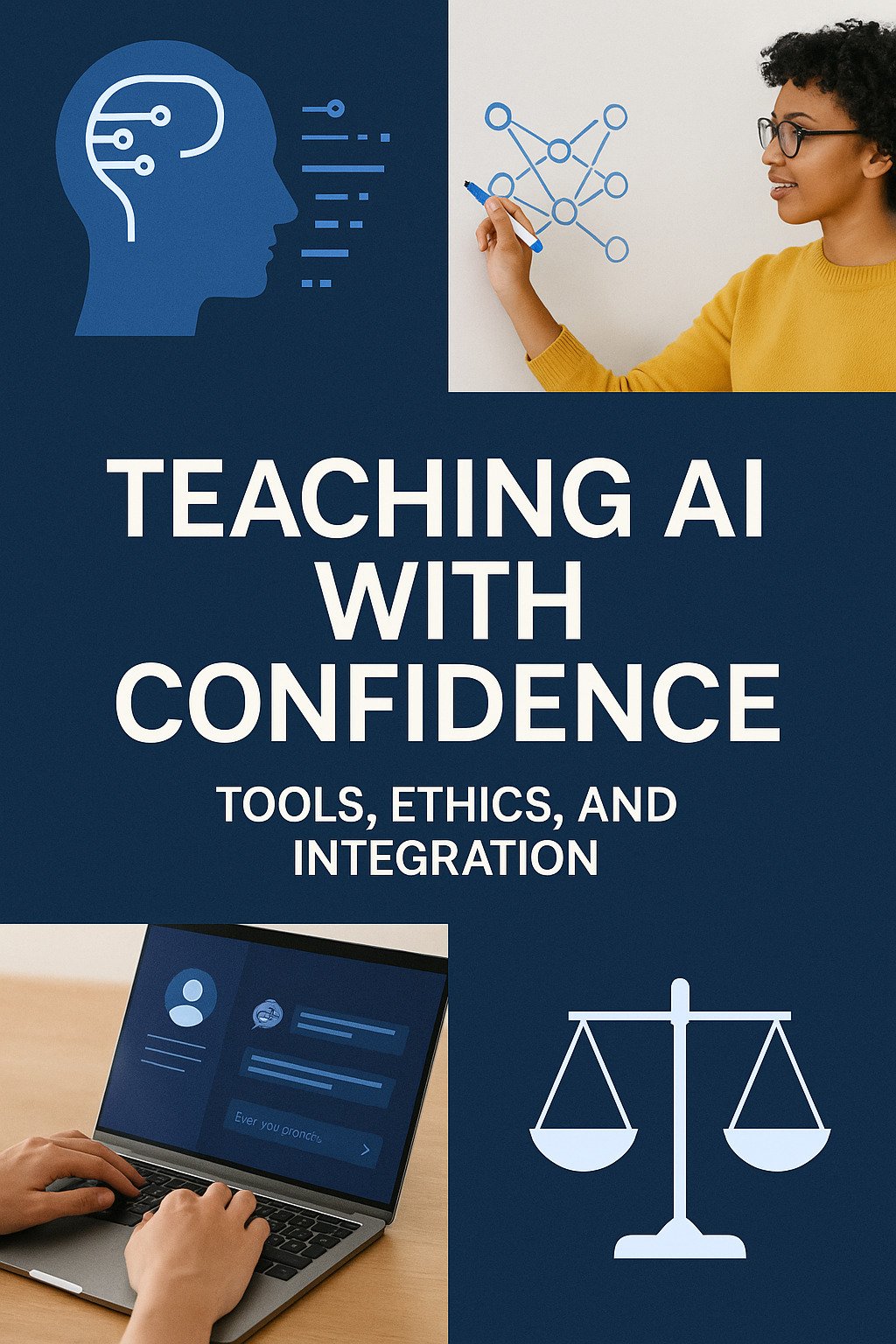


AI Guidance for Educators
“Teaching AI with Confidence: Tools, Ethics, and Integration”
Course Goals:
Build AI literacy among educators.
Empower ethical and creative classroom use.
Provide vetted tools and resources.
By participating in the “Teaching AI with Confidence” course, educators can expect to save considerable time on lesson planning, resource creation, and ethical guideline development.
The integration of AI tools and resources provided in the course can lead to more efficient teaching practices, allowing educators to focus more on student engagement and less on administrative tasks.
Topics:
Definition of Artificial Intelligence
Differences between:
AI vs. Machine Learning vs. Automation
Narrow AI vs. General AI
Common misconceptions about AI
This module introduces educators to the foundations of Artificial Intelligence, clarifies key terms, and contextualizes its role in modern classrooms. Educators will explore real-world examples and reflect on their current AI usage through a guided audit activity.
Purpose:
To help educators reflect on how AI may already be integrated into their teaching tools, workflows, or school platforms—whether they realize it or not.
Instructions:
Read through the list of common tools and teaching tasks.
Check off which ones you currently use.
Reflect on how AI may be operating behind the scenes.
Answer the reflection questions at the end.
This module introduces educators to the foundations of Artificial Intelligence, clarifies key terms, and contextualizes its role in modern classrooms. Educators will explore real-world examples and reflect on their current AI usage through a guided audit activity.
By the end of this module, educators will be able to:
Define AI and distinguish it from automation and machine learning.
Recognize the scope and limitations of AI in educational contexts.
Identify how AI is already being used, consciously or unconsciously in their teaching environments.
Begin thinking critically about responsible integration of AI tools.
By the end of this lesson, educators will:
Identify AI tools that are safe, practical, and educator-approved.
Understand how these tools align with classroom needs and learning goals.
Evaluate AI tools for safety, privacy, and ethical use.
Begin experimenting with one or more tools using guided prompts.
By the end of this lesson, educators will:
Identify AI tools that are safe, practical, and educator-approved.
Understand how these tools align with classroom needs and learning goals.
Evaluate AI tools for safety, privacy, and ethical use.
Begin experimenting with one or more tools using guided prompts.
Using ChatGPT, pick a prompt using the prompt format:
Create a ____________ (lesson plan, quiz etc.) on _____________ (subject matter), for ___________ (audience), covering __________________(objectives or outcomes). Edit your prompt according to the desired results. Continue editing until you are happy with the outcome.
Objectives:
Educators will identify age-appropriate strategies for teaching AI concepts.
Educators will recognise the cognitive level of their students and adapt explanations accordingly.
Small group discussion: Identify 2 ways to include digital citizenship in an AI lesson.
Case studies and sample lesson plans.
Objective: Help educators integrate digital citizenship principles into AI-related lessons, ensuring students use AI tools safely, ethically, and thoughtfully.
Objective:
Students will explore ethical questions around AI and develop respectful discussion and reasoning skills.
Objective:
Students will engage in structured debates on complex AI ethical dilemmas, incorporating concepts of bias, fairness, accountability, and long-term societal impact.
Avoiding misinformation and deepfakes.
Privacy and personal data.
Purpose: To spark meaningful conversations with students or staff about the ethical use of artificial intelligence in education and everyday life.
Learning Objectives:
By the end of this module, participants will be able to:
Define what it means to cultivate an AI-ready mindset in students.
Identify strategies to balance AI automation with human connection in teaching.
Prepare actionable steps to equip students for AI-influenced futures.
What is an AI-Ready Mindset?
Objective:
Discuss which tasks AI can automate (grading, scheduling, content generation).
Discuss human-only tasks: mentorship, emotional support, fostering curiosity.
Emphasize the balance: leveraging AI efficiency while nurturing human relationships.
Objective:
Overview of AI’s impact on careers, society, and problem-solving.
Discuss transferable skills: adaptability, lifelong learning, ethics, collaboration.
Highlight resources, clubs, and activities to integrate AI literacy into the curriculum.
Key takeaway: Educators are not just teaching content, they are guiding students to thrive in a world where AI is part of every domain.
How to Fact-Check and Verify AI Outputs
Here is a quick step-by-step guide on how to fact-check and verify information from AI tools.
Prompts for critical thinking and creativity.
Module Title Learning Objectives Key Activities & Resources 1 Introduction to AI in Education - Define AI and its relevance in K-12 education - Understand foundational AI concepts - Video overview - Interactive glossary - Discussion forum 2 AI Tools for Educators - Explore classroom-ready AI tools - Evaluate tools for different subjects and grade levels - Tool demos (e.g., ChatGPT, Canva, MagicSchool) - Case studies - Tool comparison worksheet 3 Ethical Considerations - Identify ethical challenges in AI use - Discuss bias, privacy, and transparency - Scenario-based activities - Ethics checklist - Group debate prompts 4 Integrating AI into Curriculum - Design AI-enhanced lesson plans - Align AI use with curriculum standards - Lesson plan templates - Curriculum alignment guide - Peer review activity 5 Student Engagement & Digital Citizenship - Teach students responsible AI use - Promote critical thinking and digital ethics - Student-facing resources - Role-play exercises - Assessment rubrics 6 Assessment & Reflection - Evaluate impact of AI integration - Reflect [Incomplete text - "and"] - Self-assessment quiz - Reflective [Incomplete text - "journaling/"]